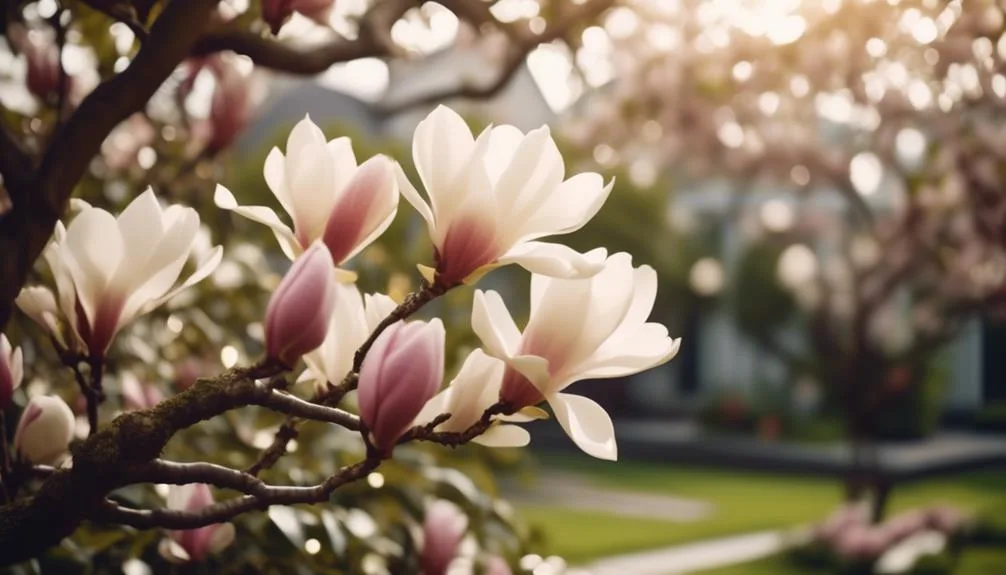Wondering how to make your garden a fragrant paradise with magnolia trees? It's all about finding the perfect spot for these majestic trees. From sunlight and soil to wind protection and proximity to living areas, there are key factors to consider for maximizing their delightful aroma.
Get ready to transform your outdoor space into a sweet-smelling haven as we explore the best planting practices for magnolia trees.
Sunlight Requirements
To ensure the healthy growth and abundant blooming of your magnolia trees, provide them with at least six hours of direct sunlight each day. Magnolias thrive in full sun, so be sure to plant them in a location where they can soak up the sunshine.
When planting your magnolia tree, make sure to dig a hole that's as deep as the root ball and two to three times as wide. Water the tree deeply after planting to help it settle into its new home.
As your magnolia tree grows, consider fertilizing it in the spring to encourage healthy growth and vibrant blooms. Pruning is also important to shape the tree and remove any dead or diseased branches.
With proper sunlight, planting depth, watering, fertilizer, and pruning, your magnolia tree will flourish and fill your garden with its delightful fragrance.
Soil Conditions
If your magnolia tree is to thrive, the soil conditions it's planted in must be carefully considered and prepared to ensure healthy growth and abundant blooming. To create the perfect environment for your magnolia tree, consider the following:
- Fertilizer Application: Magnolia trees benefit from a balanced slow-release fertilizer applied in early spring to support healthy growth and abundant flowering.
- pH Levels: Magnolias prefer slightly acidic to neutral soil with a pH range of 6.0 to 7.0. Test your soil and make adjustments using sulfur or lime to reach the ideal pH level.
- Soil Composition: Ensure the soil is well-draining and rich in organic matter to provide essential nutrients and promote a healthy root system.
Wind Protection
Considering the potential impact of wind on your magnolia tree's health and growth, it's important to implement effective wind protection measures to ensure its well-being. Sheltered locations provide optimal conditions for magnolia trees, offering protection from strong winds.
When selecting a planting site, consider the direction of prevailing winds and choose a location that minimizes wind exposure. Strong winds can't only damage the delicate branches and flowers of the magnolia tree but can also affect its fragrance retention. By planting your magnolia tree in a sheltered area, you can help preserve its aromatic blooms and ensure a more enjoyable olfactory experience in your garden.
Additionally, creating windbreaks with strategically placed shrubs or fences can further shield your magnolia tree from the detrimental effects of wind exposure.
Proximity to Living Areas
After securing a sheltered location for your magnolia tree to protect it from wind damage, you'll want to carefully consider its proximity to living areas to maximize the enjoyment of its fragrant blooms.
Tree placement: Plant the magnolia tree near windows, patios, or outdoor seating areas where you spend time. This will allow you to savor the delightful scent as it wafts through the air.
Fragrance dispersion: Position the tree in a location where prevailing winds can carry the fragrance towards your home. This can enhance the overall ambiance of your living spaces.
Consider the distance: Ensure the tree is close enough to your living areas to enjoy the fragrance, but not so close that it becomes overwhelming. Finding the perfect balance will create an inviting and aromatic environment for you and your guests.
Consideration of Other Plants
When selecting other plants to accompany your magnolia tree, choose species that will complement its fragrance and blooming season, creating a harmonious and visually appealing garden setting. Consider planting companion plants that not only enhance the fragrance combinations in your garden but also provide a stunning backdrop to showcase the magnolia tree's beauty. Here's a list of suitable companion plants to consider:
| Plant Name | Fragrance | Blooming Season |
|---|---|---|
| Gardenia | Sweet, heady | Spring |
| Jasmine | Intense, exotic | Summer |
| Lilac | Floral, delicate | Spring |
| Rose | Romantic, classic | Summer |
| Lavender | Aromatic, soothing | Summer |
These companion plants will not only add to the overall sensory experience in your garden but also create a delightful and fragrant ambiance.
Conclusion
Incorporating these considerations when planting magnolia trees can create an optimal environment for enjoying their captivating fragrance.
Selecting a sunny, sheltered location with well-draining soil, and being mindful of their surroundings, ensures the thriving growth of these trees, filling your garden with their delightful scent.
Happy planting and may your garden be filled with the sweet fragrance of magnolia blooms.

My interest in trees started when I first saw the giant sequoias in Yosemite.
I was a teenager then, and I remember thinking, “I need to learn more about this.”
That moment stuck with me.
A few years later, I went on to study forestry at Michigan Tech.
Since graduating, I’ve worked in a mix of hands-on tree care and community education.
I’ve spent over ten years helping people understand how to plant, maintain, and protect the trees in their neighborhoods.
I don’t see trees as just part of the landscape.
They are living things that make a real difference in our daily lives.
